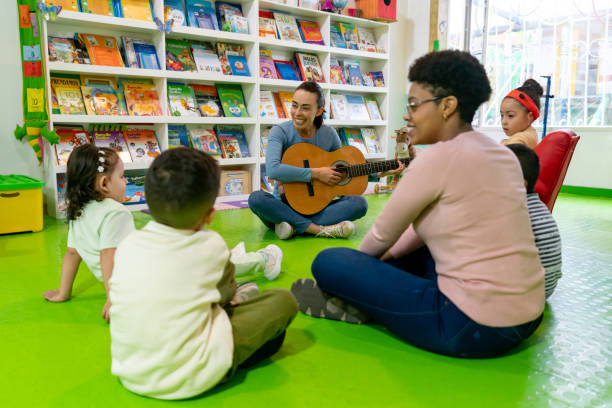Introduction
Music education holds a unique place in schools, enriching students’ lives in ways few other subjects can. It fosters creativity, discipline, self-expression, and a genuine appreciation for culture that extends beyond the classroom. Through music, students learn to collaborate, communicate, and think critically, skills that serve them throughout their lives. Yet, despite its profound benefits, music educators often encounter significant hurdles when seeking high-quality, varied teaching materials, particularly those that are both pedagogically sound and culturally relevant. These limitations can restrict the reach and impact of even the most dedicated teachers, occasionally leaving students with a narrow or outdated view of music. Consequently, access to remote and in-person music teaching resources is critical to empowering teachers to deliver engaging, relevant music curricula that excite and inspire learners at all levels.
Music education resource libraries have emerged as a powerful solution to bridge this gap. Specifically designed for educators’ evolving needs, these libraries offer wide-ranging collections spanning every conceivable musical genre and pedagogical method. Whether a teacher seeks sheet music for a classical symphony, resources for jazz improvisation, or instructional videos on global rhythms, these libraries ensure that diverse and accessible content is always within reach. This wealth of resources not only supports curriculum development and innovation but also plays a vital role in sustaining student engagement and cultivating a lifelong passion for music.
The Role of Music Education Resource Libraries
At the core of effective school music programs are libraries tailored to the specific demands of music educators and their students. These repositories house expansive selections of sheet music, reference books, lesson plans, audio recordings, digital applications, and multimedia content, all curated to meet varied curricular goals and classroom environments. By thoughtfully assembling these collections, libraries empower teachers to draw from a rich musical tapestry: from classical masterpieces to local folk traditions, from contemporary pop hits to experimental world music. This diversity enables schools to offer students a dynamic and inclusive musical experience. As eSchool News highlights, promoting music education through innovative teaching resources and accessible materials is key to nurturing students’ creativity and engagement in the arts.
The breadth of materials ensures that teachers can continuously refresh their lesson plans to maintain student interest and cater to different learning styles. Resource libraries also frequently include access to rare, out-of-print, or specialized materials that could otherwise be cost-prohibitive or difficult for individual schools and teachers to obtain. These unique items greatly enhance the depth and richness of classroom instruction, enabling students to encounter music they might not hear elsewhere.
Enhancing Curriculum with Diverse Materials
Integrating a rich variety of musical works into a curriculum does more than build technical skill; it strengthens students’ social and cultural awareness. These resources expand students’ worldviews, allowing them to connect with music that reflects their own backgrounds or introduces them to new perspectives. Through carefully selected repertoire and teaching materials, students gain an understanding of diverse cultures and historical contexts, fostering empathy and cultural competence.
In addition to expanding cultural horizons, curated playlists and repertoire lists help teachers adapt more efficiently to the changing tastes and demographics of their classrooms. Tailored lesson plans, project guides, and differentiated resources support educators in meeting the unique needs of English language learners, students with disabilities, or those with limited musical backgrounds. Ultimately, expanding curricular options through resource libraries allows schools to create inclusive environments where every student can see their identity and heritage reflected in the music they study, fostering a deeper sense of belonging and pride in the classroom.
Supporting Professional Development
Music education resource libraries extend their impact beyond students by serving as invaluable centers for teacher development. A well-equipped library offers much more than just music scores; it becomes a hub for professional development. Within these collections, educators can find guides on curriculum design, instructional innovation, classroom management, and technology integration. There are resources to help teachers stay up to date on the latest educational research, trends in music pedagogy, and changes in national standards.
When teachers engage in ongoing professional development, they become more confident and effective in fostering student engagement, managing diverse classrooms, and introducing new pedagogical approaches. Whether learning to use digital composition tools, implementing culturally responsive practices, or exploring assessment approaches, educators can pursue their own lifelong learning through the support of resource libraries. In this way, libraries are not simply repositories—they are engines of professional rejuvenation and excellence for music teachers everywhere.
Facilitating Access to Technology and Innovation
Technology has revolutionized how music is taught and learned, and resource libraries ensure that teachers have access to the latest educational tools. Digital archives, streaming music services, interactive notation software, and cloud-based collaboration platforms are just a few examples of resources that can transform traditional music classrooms into dynamic learning spaces. Teachers can create multimedia-rich presentations, facilitate virtual ensemble rehearsals, or introduce students to music recording and production through user-friendly apps.
These technology-driven resources empower teachers to deliver engaging, hands-on lessons, helping students grasp complex concepts through interactive activities. The availability of digital materials also levels the playing field for students and educators, providing high-quality music education regardless of geographic location or resource constraints. Online portals, streaming lessons, and global virtual masterclasses enable students in rural or underserved schools to experience the same level of instruction as their peers in urban centers.
Building Community and Collaboration
Music education resource libraries also play a vital role in community building by facilitating collaboration among teachers, students, and local musicians. These libraries often organize workshops, professional learning communities, and collaborative projects that bring educators together, both locally and virtually. Events such as reading sessions, subject-specific seminars, and group planning days offer teachers opportunities to exchange ideas, share best practices, and even co-develop engaging new curricula tailored to their schools’ needs.
Such collaboration not only strengthens individual educators but also benefits entire school communities. Students benefit from a richer, more diverse learning environment when their teachers can pool resources and expertise. Joint performances, school-wide arts initiatives, and regional music festivals become easier to organize and sustain through the networking made possible by resource libraries. In these dynamic spaces, teachers form long-lasting partnerships and are inspired to drive innovative musical initiatives that might be impossible to achieve in isolation.
Overcoming Challenges in Resource Accessibility
Despite their enormous potential, music education resource libraries still face challenges in ensuring equitable access for all teachers and students. Educators in remote or underfunded regions may lack the funding, infrastructure, or administrative support needed to fully tap into these resources. To address these barriers, library networks are increasingly focusing on expanding their digital offerings and forming partnerships with national organizations, cultural institutions, and technology providers.
Securing grants for technology, establishing interlibrary sharing agreements, and encouraging open-source content creation are also important strategies for broadening the reach of resource libraries. Ultimately, it is through these collaborative and innovative approaches that even the most isolated schools can be connected to the broader world of music education.
Conclusion
Music education resource libraries are essential allies in elevating the teaching and learning of music for the next generation. They not only equip teachers with diverse and high-quality instructional materials but also offer invaluable professional development, foster technological innovation, and build vibrant collaborative communities among educators. By addressing disparities in access and promoting inclusivity, these libraries ensure that every school and every teacher has the resources needed to guide students on their musical journeys. With thoughtful support and continued investment in resource libraries, schools can curate a future where musical success is within reach for every child, igniting a lifelong passion for music that continues beyond graduation.





Leave a Reply